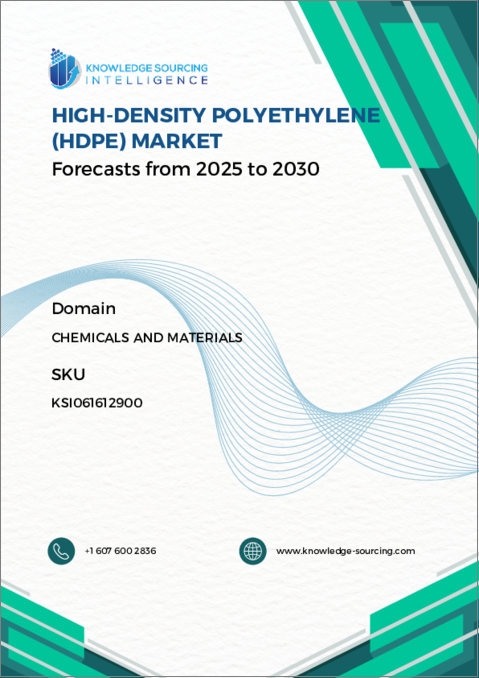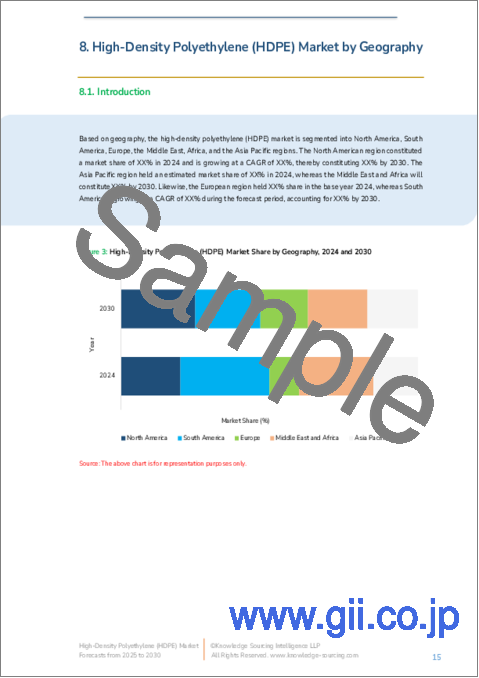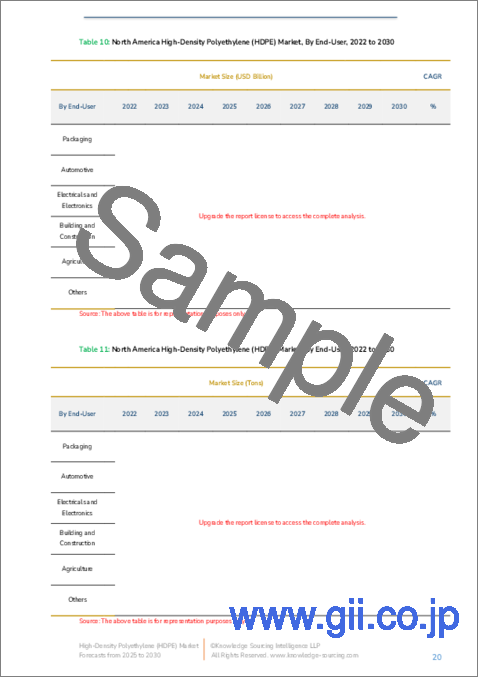|
|
市場調査レポート
商品コード
1627168
高密度ポリエチレン(HDPE)市場:予測(2025年~2030年)High-Density Polyethylene (HDPE) Market - Forecasts from 2025 to 2030 |
||||||
カスタマイズ可能
|
|||||||
| 高密度ポリエチレン(HDPE)市場:予測(2025年~2030年) |
|
出版日: 2024年11月20日
発行: Knowledge Sourcing Intelligence
ページ情報: 英文 146 Pages
納期: 即日から翌営業日
|
全表示
- 概要
- 目次
高密度ポリエチレン(HDPE)市場は、2025年には1,035億4,600万米ドルとなり、CAGR4.09%で成長し、2030年には1,265億800万米ドルになると予測されています。
高密度ポリエチレン(HDPE)は石油ベースの熱可塑性ポリマーです。現在存在するプラスチックの中で最も汎用性が高く、ペットボトルから牛乳瓶、シャンプーボトル、漂白剤ボトル、まな板、配管などあらゆるものに使用されています。HDPEプラスチックは、優れた引張強度と、所定の耐衝撃性と融点に対する大きな強度対密度の比を誇っています。
HDPEの成長は主に、特に消費者製品の間で持続可能なパッケージングに対する需要が高まっていることが背景にあります。
HDPEは、その強度と耐薬品性を生かすため、主にパイプや地中膜の建設に応用されています。また、生産技術のさらなる進歩により、HDPEはより経済的で汎用性の高い材料となっています。軽量で耐衝撃性に優れているため、燃料を節約する自動車産業での使用に適しています。また、HDPEのリサイクル性は、より持続可能な循環型経済への移行を後押ししています。
高密度ポリエチレン(HDPE)市場の促進要因
- パッケージ需要の拡大
HDPE市場の主な成長要因は、食品・飲料、家庭用品、eコマース用パッケージなど、消費財用途のパッケージ需要の増加です。HDPEは強靭で耐久性があり、湿気や紫外線、化学薬品に強いため、こうした用途に理想的な材料です。英国は、中国、米国に次いで、電子商取引市場の世界第3位を占めています。消費者向けeコマースは現在、英国の小売市場全体の36.3%を占めており(2021年1月現在)、eコマースの売上高は2025年までに2,856億米ドルに達すると予想されています。
さらに、HDPEのリサイクル性と環境に優しい特性は、持続可能性に対する世界の関心の高まりと共鳴しています。消費者とブランドはともに、プラスチック廃棄物を減らすためにリサイクル可能な材料に関心を寄せています。製造業者にとって包装コストは重要であり、HDPEの手頃な価格と軽量の特性はその採用を後押ししています。より安全でエコロジーを意識したパッケージングに対する消費者ニーズの変化や、持続可能な材料に対する法規制の強化により、HDPEは今後のパッケージング分野の成長が見込まれています。
高密度ポリエチレン(HDPE)市場は世界5地域に区分されます:
地域別に見ると、HDPE市場は北米、南米、欧州、中東・アフリカ、アジア太平洋に分けられます。北米のHDPE市場は、特にボトル、容器、食品包装などの包装用途での高い需要が牽引しています。例えば、米国商務省国勢調査局のCounty Business Patternsによると、2021年の米国には41,080の食品・飲料加工工場がありました。カリフォルニア州の食品・飲料製造工場が最も多く(6,301)、テキサス州(2,782)とニューヨーク州(2,662)も主要な食品・飲料製造州であり、市場拡大をさらに後押ししています。
消費者や企業からは持続可能な解決策を求める圧力があり、市場をさらに牽引しています。プラスチック廃棄物を止めよという大きな規制圧力を受けて、この地域はHDPEのようなリサイクル可能な材料を採用することで、環境の持続可能性をより重視する姿勢を示しています。パイプ、継手、ジオメンブレンなど、その他の建設製品におけるHDPEの用途も、その堅牢性と耐薬品性により拡大しています。
アジア太平洋のHDPE市場は、急速な工業化と都市化によっても活性化しています。消費財の包装におけるHDPEの使用は急速に拡大しています。
例えば、インドの食品・飲料包装事業は年率14.8%で成長し、2029年には860億米ドルに達すると予測されています。環境に関する意識の高まりと政府の規範により、HDPEのリサイクル可能な材料の利用が進んでいます。アジア太平洋地域では原料価格が安く、生産コストが低下しているため、さまざまな産業で幅広く使用されています。水、衛生、廃棄物管理における政府の取り組みに加え、インフラへの高額の投資がHDPEの需要を煽っています。さらに、インド規格局(BIS)は化学、石油、石炭、関連製品(PCD)および繊維部門(TXD)と協力して、持続可能な包装に関するインド規格を開発しています。
このレポートを購入する理由
- 洞察に満ちた分析:主要地域および新興地域を網羅し、顧客セグメント、政府政策と社会経済要因、消費者選好、産業別、その他のサブセグメントに焦点を当てた詳細な市場考察を得ることができます。
- 競合情勢:世界の主要企業が採用している戦略的策略を理解し、適切な戦略による市場浸透の可能性を理解することができます。
- 市場動向と促進要因:ダイナミックな要因と極めて重要な市場動向、そしてそれらが今後の市場展開をどのように形成していくかを探ります。
- 実行可能な提言:ダイナミックな環境の中で新たなビジネスストリームと収益を発掘するための戦略的決断を下すために、洞察を活用します。
- 幅広い利用者に対応:新興企業、研究機関、コンサルタント、中小企業、大企業にとって有益で費用対効果に優れています。
どのような用途で利用されていますか?
業界と市場考察、事業機会評価、製品需要予測、市場参入戦略、地理的拡大、設備投資の決定、規制の枠組みと影響、新製品開拓、競合の影響
調査範囲
- 2022年から2030年までの実績データと予測
- 成長機会、課題、サプライチェーンの展望、規制枠組み、顧客行動、動向分析
- 競合のポジショニング、戦略、市場シェア分析
- セグメントと各国を含む地域の収益成長および予測分析
- 企業のプロファイリング(戦略、製品、財務状況、主な発展など)
目次
第1章 イントロダクション
- 市場概要
- 市場の定義
- 調査範囲
- 市場セグメンテーション
- 通貨
- 前提条件
- 基準年と予測年のタイムライン
- 利害関係者にとっての主なメリット
第2章 調査手法
- 調査デザイン
- 調査プロセス
第3章 エグゼクティブサマリー
- 主な調査結果
- アナリストビュー
第4章 市場力学
- 市場促進要因
- 包装の需要の高まり
- 持続可能性への注目の高まり
- 市場抑制要因
- 環境問題
- 原材料価格の変動
- ポーターのファイブフォース分析
- 業界バリューチェーン分析
第5章 高密度ポリエチレン(HDPE)市場:用途別
- イントロダクション
- パイプ・チューブ
- 硬質品
- シート・フィルム
- その他
第6章 高密度ポリエチレン(HDPE)市場:エンドユーザー業界別
- イントロダクション
- パッケージ
- 交通機関
- 電気・電子
- 建築・建設
- 農業
- その他
第7章 高密度ポリエチレン(HDPE)市場:地域別
- 世界概要
- 北米
- 米国
- カナダ
- メキシコ
- 南米
- ブラジル
- アルゼンチン
- その他南米
- 欧州
- 英国
- ドイツ
- フランス
- イタリア
- スペイン
- その他欧州地域
- 中東・アフリカ
- サウジアラビア
- アラブ首長国連邦
- その他中東・アフリカ
- アジア太平洋
- 中国
- インド
- 日本
- 韓国
- 台湾
- タイ
- インドネシア
- その他アジア太平洋
第8章 競合環境と分析
- 主要企業と戦略分析
- 市場シェア分析
- 合併、買収、合意、コラボレーション
- 競合ダッシュボード
第9章 企業プロファイル
- Dow Inc,
- WL Plastics
- Asva Corporation
- PTT Global Chemical
- Chevron Philips Chemical
- Univation Technologies
- Total Energies
- Lummus Technology
- Prince Pipes
- United Poly Systems
- Sovereign Pipe Technologies
- Tijaria Polypipes Ltd.
The high-density polyethylene (HDPE) market is anticipated to be valued at US$103.546 billion in 2025, growing at a CAGR of 4.09% to make US$126.508 billion in 2030.
High-Density Polyethylene (HDPE) is a petroleum-based thermoplastic polymer. It is one of the most versatile forms of plastic in existence today and is used for everything from plastic bottles to milk jugs, shampoo bottles, bleach bottles, cutting boards, and piping. HDPE plastic boasts outstanding tensile strength and a large strength-to-density ratio for a given impact resistance and melting point.
The growth in HDPE is mainly driven by the rising demand for sustainable packaging, particularly among consumer products.
HDPE finds its application mainly in construction in pipes and geo-membranes to reap its strength and chemical resistance. Further advancement in production technology has also made HDPE more economical and versatile. Its lightness and ability to be impact-resistant make the material fit for use in automotive industries to save fuel. Its recyclability also supports the move toward more sustainable, circular economy practices.
High-density polyethylene (HDPE) market drivers
- Growing demand for Packaging
The main growth driver for the HDPE market comes from increasing demand for packaging from consumer goods applications, such as food and beverage, household products, and e-commerce packaging. HDPE is strong, durable, and resistant to moisture, UV, and chemicals, making it an ideal material for these applications. The United Kingdom holds the third place on the global list of the largest eCommerce markets, after China and the USA. Consumer eCommerce presently accounts for 36.3% of the overall retail market in the UK (as of January 2021), with eCommerce sales expected to reach $285.60 billion by 2025.
Additionally, HDPE's recyclability and eco-friendly attributes resonate with the growing global concern towards sustainability: both consumers and brands are concerned with recyclable materials to reduce plastic waste. Packaging expenses are critical for manufacturers, and HDPE's affordability and lightweight character enhance its adoption. With changing consumer needs for safer, ecologically conscious packaging and increasing regulation support for sustainable materials, HDPE is expected to grow in the future of the packaging sector.
The high-density polyethylene (HDPE) market is segmented into five regions worldwide:
Geography-wise, the HDPE market is divided into North America, South America, Europe, the Middle East and Africa, and Asia Pacific. The North American HDPE market is driven by high demand in packaging applications, especially bottles, containers, and food packaging. For instance, according to the U.S. Department of Commerce's Bureau of the Census's County Business Patterns, there were 41,080 food and beverage processing factories in the United States in 2021. California had the most food and beverage manufacturing plants (6,301), while Texas (2,782) and New York (2,662) were also major food and beverage manufacturing states, further fueling the market expansion.
There is pressure from consumers and companies for sustainable solutions, further driving the market. In response to significant regulatory pressure to stop plastic waste, the region has demonstrated a greater emphasis on environmental sustainability by adopting recyclable materials such as HDPE. Other applications of HDPE in other construction products, like pipes, fittings, and geo-membranes, are also growing due to its robustness and chemical resistance.
The Asia Pacific HDPE market is also fueled by rapid industrialization and urbanization. The use of HDPE in packaging consumer goods is growing rapidly.
For instance, it is projected that India's food and beverage packaging business will grow at a 14.8% annual rate and reach $86 billion by 2029. Increasing awareness regarding the environment, along with government norms, has been making the use of recyclable materials of HDPE. Low raw material prices and decreased production costs in the Asia Pacific encourage extensive usage in various industries. High investments in infrastructure, along with government initiatives in water, sanitation, and waste management, fuel the demand for HDPE. Furthermore, the Bureau of Indian Standards (BIS) collaborates with the Chemical, Petroleum, Coal, and Related Products (PCD) and Textile departments (TXD) to develop Indian standards for sustainable packaging.
Reasons for buying this report:-
- Insightful Analysis: Gain detailed market insights covering major as well as emerging geographical regions, focusing on customer segments, government policies and socio-economic factors, consumer preferences, industry verticals, other sub- segments.
- Competitive Landscape: Understand the strategic maneuvers employed by key players globally to understand possible market penetration with the correct strategy.
- Market Drivers & Future Trends: Explore the dynamic factors and pivotal market trends and how they will shape up future market developments.
- Actionable Recommendations: Utilize the insights to exercise strategic decision to uncover new business streams and revenues in a dynamic environment.
- Caters to a Wide Audience: Beneficial and cost-effective for startups, research institutions, consultants, SMEs, and large enterprises.
What do businesses use our reports for?
Industry and Market Insights, Opportunity Assessment, Product Demand Forecasting, Market Entry Strategy, Geographical Expansion, Capital Investment Decisions, Regulatory Framework & Implications, New Product Development, Competitive Intelligence
Report Coverage:
- Historical data & forecasts from 2022 to 2030
- Growth Opportunities, Challenges, Supply Chain Outlook, Regulatory Framework, Customer Behaviour, and Trend Analysis
- Competitive Positioning, Strategies, and Market Share Analysis
- Revenue Growth and Forecast Assessment of segments and regions including countries
- Company Profiling (Strategies, Products, Financial Information, and Key Developments among others)
The high-density polyethylene (HDPE) market is segmented and analyzed as follows:
By Application
- Pipes and Tubes
- Rigid Articles
- Sheets and Films
- Others
By End-User Industry
- Packaging
- Transportation
- Electrical and Electronics
- Building and Construction
- Agriculture
- Others
By Geography
- North America
- USA
- Canada
- Mexico
- South America
- Brazil
- Argentina
- Rest of South America
- Europe
- United Kingdom
- Germany
- France
- Italy
- Spain
- Rest of Europe
- Middle East and Africa
- Saudi Arabia
- UAE
- Rest of the Middle East and Africa
- Asia Pacific
- China
- India
- Japan
- South Korea
- Taiwan
- Thailand
- Indonesia
- Rest of Asia-Pacific
TABLE OF CONTENTS
1. INTRODUCTION
- 1.1. Market Overview
- 1.2. Market Definition
- 1.3. Scope of the Study
- 1.4. Market Segmentation
- 1.5. Currency
- 1.6. Assumptions
- 1.7. Base and Forecast Years Timeline
- 1.8. Key benefits for the stakeholders
2. RESEARCH METHODOLOGY
- 2.1. Research Design
- 2.2. Research Process
3. EXECUTIVE SUMMARY
- 3.1. Key Findings
- 3.2. Analyst View
4. MARKET DYNAMICS
- 4.1. Market Drivers
- 4.1.1. Growing Demand for Packaging
- 4.1.2. Increasing Focus on Sustainability
- 4.2. Market Restraints
- 4.2.1. Environmental Concerns
- 4.2.2. Fluctuations in Raw Material Prices
- 4.3. Porter's Five Forces Analysis
- 4.3.1. Bargaining Power of Suppliers
- 4.3.2. Bargaining Power of Buyers
- 4.3.3. The Threat of New Entrants
- 4.3.4. Threat of Substitutes
- 4.3.5. Competitive Rivalry in the Industry
- 4.4. Industry Value Chain Analysis
5. HIGH-DENSITY POLYETHYLENE (HDPE) MARKET BY APPLICATION
- 5.1. Introduction
- 5.2. Pipes and Tubes
- 5.3. Rigid Articles
- 5.4. Sheets and Films
- 5.5. Others
6. HIGH-DENSITY POLYETHYLENE (HDPE) MARKET BY END-USER INDUSTRY
- 6.1. Introduction
- 6.2. Packaging
- 6.3. Transportation
- 6.4. Electrical and Electronics
- 6.5. Building and Construction
- 6.6. Agriculture
- 6.7. Others
7. HIGH-DENSITY POLYETHYLENE (HDPE) MARKET BY GEOGRAPHY
- 7.1. Global Overview
- 7.2. North America
- 7.2.1. United States
- 7.2.2. Canada
- 7.2.3. Mexico
- 7.3. South America
- 7.3.1. Brazil
- 7.3.2. Argentina
- 7.3.3. Rest of South America
- 7.4. Europe
- 7.4.1. United Kingdom
- 7.4.2. Germany
- 7.4.3. France
- 7.4.4. Italy
- 7.4.5. Spain
- 7.4.6. Rest of Europe
- 7.5. Middle East and Africa
- 7.5.1. Saudi Arabia
- 7.5.2. United Arab Emirates
- 7.5.3. Rest of the Middle East and Africa
- 7.6. Asia-Pacific
- 7.6.1. China
- 7.6.2. India
- 7.6.3. Japan
- 7.6.4. South Korea
- 7.6.5. Taiwan
- 7.6.6. Thailand
- 7.6.7. Indonesia
- 7.6.8. Rest of Asia-Pacific
8. COMPETITIVE ENVIRONMENT AND ANALYSIS
- 8.1. Major Players and Strategy Analysis
- 8.2. Market Share Analysis
- 8.3. Mergers, Acquisitions, Agreements, and Collaborations
- 8.4. Competitive Dashboard
9. COMPANY PROFILES
- 9.1. Dow Inc,
- 9.2. WL Plastics
- 9.3. Asva Corporation
- 9.4. PTT Global Chemical
- 9.5. Chevron Philips Chemical
- 9.6. Univation Technologies
- 9.7. Total Energies
- 9.8. Lummus Technology
- 9.9. Prince Pipes
- 9.10. United Poly Systems
- 9.11. Sovereign Pipe Technologies
- 9.12. Tijaria Polypipes Ltd.






